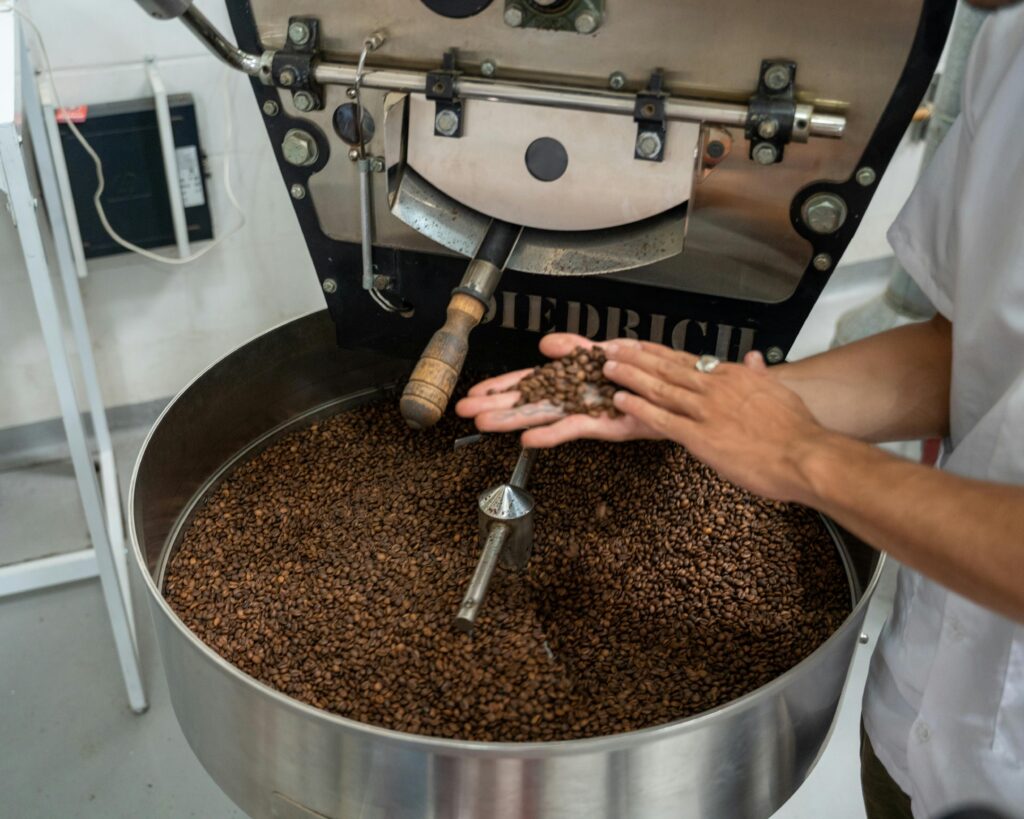Section 5: Advanced Roasting Techniques

Elevating Your Roasting Skills
Once you’ve mastered the basics of coffee roasting, it’s time to delve into advanced techniques that can elevate your roasting skills and bring out the best in your beans. Advanced roasting techniques allow you to fine-tune your roasts, experiment with different flavor profiles, and achieve greater consistency and control. In this section, we will explore various advanced roasting techniques and tips for honing your craft.
Understanding Roasting Curves
A roasting curve is a graphical representation of the temperature changes that occur during the roasting process. By plotting the temperature of the beans over time, you can visualize the roast’s progression and make precise adjustments.
Charge Temperature:
- Description: The initial temperature at which the green coffee beans are added to the roaster.
- Importance: Affects the overall development of the roast. Higher charge temperatures can lead to faster roasting times, while lower temperatures provide a slower, more controlled roast.
Turning Point:
- Description: The point at which the beans’ temperature reaches its lowest before beginning to rise.
- Importance: Indicates the start of the roasting process. Monitoring this point helps you understand how quickly the beans absorb heat.
Rate of Rise (RoR):
- Description: The rate at which the temperature of the beans increases, usually measured in degrees per minute.
- Importance: Controlling the RoR is crucial for managing the roast profile. A high RoR can lead to a fast roast with potential for underdevelopment, while a low RoR ensures a more gradual development of flavors.
Development Time Ratio (DTR):
- Description: The percentage of the total roast time spent in the development phase (after the first crack).
- Importance: Balances the development of flavors. A typical DTR ranges from 20-25%, but this can vary depending on the desired roast profile.
Profiling and Experimentation
Creating a Roasting Profile:
- Description: A roasting profile is a detailed plan that outlines the temperature and time parameters for a specific roast.
- How to Create:
- Choose a desired roast level and flavor profile.
- Set initial parameters (charge temperature, RoR, and DTR).
- Conduct a test roast and record the data.
- Evaluate the results and adjust the parameters as needed.
- Repeat the process until you achieve the desired profile.
Experimenting with Different Profiles:
- Description: Experimentation is key to discovering unique flavors and perfecting your roasting technique.
- Tips for Experimenting:
- Vary the charge temperature to see how it affects the initial stages of the roast.
- Adjust the RoR during different phases to balance the development of flavors.
- Experiment with different DTR percentages to enhance specific flavor notes.
Advanced Roasting Techniques
Stretching the Maillard Phase:
- Description: The Maillard phase is critical for developing complex flavors. Stretching this phase can enhance sweetness and body.
- How to Stretch:
- Lower the RoR during the Maillard phase to prolong the browning process.
- Monitor the color and aroma changes to avoid underdevelopment or scorching.
Manipulating the Development Phase:
- Description: The development phase determines the final flavor profile of the coffee. Manipulating this phase allows you to highlight or subdue specific flavors.
- How to Manipulate:
- Increase the RoR slightly after the first crack to intensify certain flavor notes.
- Extend or shorten the development time to achieve the desired balance between acidity, sweetness, and bitterness.
Post-Roast Blending:
- Description: Blending different roast levels of the same bean or different beans can create a complex and balanced cup.
- How to Blend:
- Roast separate batches to different levels (e.g., light, medium, and dark).
- Experiment with different ratios of each roast level to create a unique blend.
- Cup the blends to evaluate and refine the ratios.
Using Technology for Advanced Roasting
Roasting Software:
- Description: Advanced roasting software can track and analyze your roasts in real-time, providing valuable data for refining your profiles.
- Popular Software: Artisan, Cropster, and RoastLogger.
- How to Use:
- Connect the software to your roaster’s data logging hardware.
- Set up the software to record temperature, time, and RoR.
- Use the data to identify trends and make precise adjustments to your profiles.
Probes and Sensors:
- Description: High-quality probes and sensors provide accurate temperature readings and improve control over the roasting process.
- Types of Probes:
- Bean Temperature Probe: Measures the temperature of the beans directly.
- Environmental Temperature Probe: Measures the temperature inside the roaster chamber.
- How to Use:
- Install the probes in the appropriate locations on your roaster.
- Calibrate the probes to ensure accurate readings.
- Monitor the data to make informed adjustments during the roast.
Troubleshooting Common Roasting Issues
Underdevelopment:
- Description: Underdeveloped coffee lacks sweetness and complexity, often tasting grassy or vegetal.
- Solutions:
- Increase the charge temperature to ensure a more aggressive start.
- Extend the Maillard phase to allow more time for flavor development.
- Adjust the RoR to balance the heat application throughout the roast.
Overdevelopment:
- Description: Overdeveloped coffee can taste burnt or ashy, with a loss of origin character.
- Solutions:
- Lower the charge temperature to reduce initial heat intensity.
- Shorten the development phase to prevent excessive caramelization.
- Monitor the color and aroma closely to avoid over-roasting.
Scorching:
- Description: Scorching occurs when the beans’ surface burns due to excessive heat, resulting in bitter and charred flavors.
- Solutions:
- Reduce the charge temperature to avoid an aggressive start.
- Ensure even heat distribution by stirring or agitating the beans.
- Use a lower RoR to control the heat application.
Conclusion
Advanced roasting techniques provide the tools and knowledge to refine your roasting process and achieve exceptional results. By understanding and manipulating roasting curves, experimenting with different profiles, and utilizing technology, you can elevate your coffee roasting skills to new heights. Remember, coffee roasting is an art that requires continuous learning and experimentation. Embrace the journey, and enjoy the process of discovering the full potential of your coffee beans.
Happy roasting!